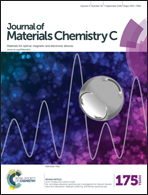Effects of alloying on the optical properties of organic–inorganic lead halide perovskite thin films†
Abstract
Complex refractive index and dielectric function spectra of organic–inorganic lead halide perovskite alloy thin films are presented, together with the critical-point parameter analysis (energy and broadening) of the respective composition. Thin films of methylammonium lead halide alloys (MAPbI3, MAPbBr3, MAPbBr2I, and MAPbBrI2), formamidinium lead halide alloys (FAPbI3, FAPbBr3, and FAPbBr2I), and formamidinium cesium lead halide alloys [FA0.85Cs0.15PbI3, FA0.85Cs0.15PbBrI2, and FA0.85Cs0.15Pb(Br0.4I0.6)3] were studied. The complex refractive index and dielectric functions were determined by spectroscopic ellipsometry (SE) in the photon energy range of 0.7–6.5 eV. Critical point energies and optical transitions were obtained by lineshape fitting to the second-derivative of the complex dielectric function data of these thin films as a function of alloy composition. Absorption onset in the vicinity of the bandgap, as well as critical point energies and optical band transition shift toward higher energies as the concentration of Br in the films increases. Cation alloying (Cs+) has less effect on the optical properties of the thin films compared to halide mixed alloys. The reported optical properties can help to understand the fundamental properties of the perovskite materials and also be used for optimizing or designing new devices.



 Please wait while we load your content...
Please wait while we load your content...